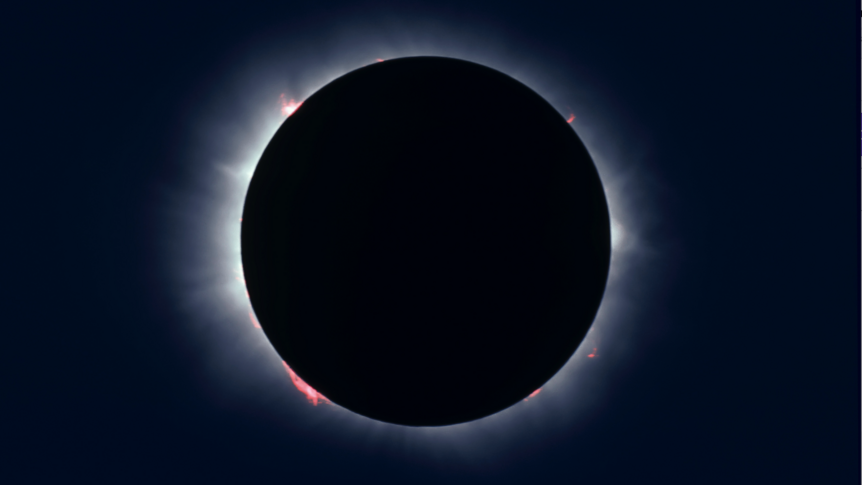Create a free profile to get unlimited access to exclusive videos, sweepstakes, and more!
NASA's solar missions compose stunning new map of the Sun's magnetic fields

The solar chromosphere is one of the most elusive and mysterious components of our star's atmospheric layers, existing between the Sun's brilliant surface and the shimmering corona and only seen in red-ringed glimpses at the climax of a total solar eclipse. It's a turbulent and unexplored region of wild temperature fluctuations and intense magnetic fields that drive our home star's hot temper.
In a monumental project achieved with the cooperation of several NASA missions, scientists have now gazed into the chromosphere using the combined efforts of two orbiting observatories and the Chromospheric Layer Spectropolarimeter 2 (CLASP2) mission bound to a suborbital rocket.
Their observations and conclusions, published last week in the online journal Science Advances, delivered multi-height measurements of the Sun's magnetic field to aid in explaining how surface magnetic fields might cause massive eruptions in its outer atmosphere.
Violent solar eruptions can cause havoc in our solar system's weather patterns, and the Sun's magnetic field is the main culprit, emitting invisible waves that ripple out into our planetary neighborhood and beyond Earth.
“The Sun is both beautiful and mysterious, with constant activity triggered by its magnetic fields,” said study lead author Ryohko Ishikawa, solar physicist at Tokyo's National Astronomical Observatory of Japan.
But it's a tricky thing to observe directly, and these magnetic bands beams into space can only be witnessed by light emanating from super-heated plasma that shoots out like a flashlight into the void. The specific arrangement of these magnetic lines arrange determines the intensity of solar activity between a calm Sun and a sudden solar eruption.
Past research has acknowledged that the volatile plasma was far too sparse to obtain accurate readings, so researchers opted instead to measure the densely-packed photosphere two layers below, where the Sun's visible light shines from. Mathematical models were then employed to extrapolate out data while directly skipping the unpredictable complexity of the chromosphere and getting an incomplete picture of the entire magnetic field.
“The chromosphere is a hot, hot mess,” explained Laurel Rachmeler, former NASA project scientist for CLASP2. “We make simplifying assumptions of the physics in the photosphere, and separate assumptions in the corona. But in the chromosphere, most of those assumptions break down.”
To solve those issues, U.S., Japan, Spain and France joined forces to develop a different technique to measure the chromosphere’s magnetic field by mounting their solar observatory on a sounding rocket. These specialized measuring tools blast into space for brief observations before dropping back to Earth.
For their innovative approach, the CLASP2 team bypassed the chaotic uncertainties of previous methods by measuring “circular polarization,” a mild shift in the light’s orientation that occurs as part of the Zeeman effect, which refers to spectral lines splintering in the presence of powerful magnetic fields. The more the lines separate, the more intense the magnetic field.
Their solar-centric rocket launched from New Mexico's White Sands Missile Range and attained an altitude of 170 miles for an eagle-eyed view of our host star from above Earth’s atmosphere, targeting the edge of an "active region" on the Sun where magnetic fields thrived.
While CLASP2 stared at the Sun, NASA’s Interface Region Imaging Spectrograph (IRIS) and the JAXA/NASA Hinode satellite adjusted their telescopes from Earth orbit to aim at this same solar spot but at different depths. This allowed for an unprecedented four-layer look inside and around the elusive chromosphere for the first time.
“When Ryohko first showed me these results, I just couldn't stay in my seat,” said David McKenzie, CLASP2 principal investigator at NASA’s Marshall Space Flight Center. “I know it sounds esoteric – but you've just showed the magnetic field at four heights at the same time. Nobody does that!
“At the Sun’s surface we see magnetic fields changing over short distances; higher up those variations are much more smeared out. In some places, the magnetic field didn't reach all the way up to the highest point we measured whereas in other places, it was still at full strength.”
The international crew is excited to expand the scope of their project and utilize this multi-pronged for more multi-height magnetic measurements of the whole chromosphere’s magnetic field, allowing for more accurate predicitons of space weather, as well as gathering vital clues to expand our knowledge of the Sun's intricate atmosphere.
“I'm a coronal physicist – I'm really interested in the magnetic fields up there,” Rachmeler added. “Being able to raise our measurement boundary to the top of the chromosphere would help us understand so much more, help us predict so much more – it would be a huge step forward in solar physics.”





























